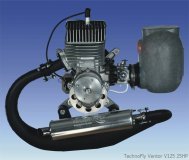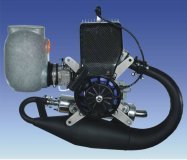Miniplane Paramotors
Products
Resources
Flying Paragliders
|
|
TechnoFly Ventor Paramotor
New! The TechnoFly Ventor motor will soon be available on the Miniplane ABM in 25 hp!
The Ventor motor was originally designed specifially for powered paragliding applications. This motor's contruction is Polish, designed from the ground up rather than adapting an existing engine or components. Using computer modeling and design, the company has successfully developed crankcase, gear and other motor components weighing more than 4 kg less than the lightest competitor engines of the same capacity. It is also worth noting that the closest competor's motor of similar weight does not have a clutch and gears! The Ventor has achieved a sensational power-to-weight ratio without sacrificing strength and durability.

Ventor obtains its great power thanks to the innovative design of the crankcase space, which drastically accelerated the exchange of energy. The rate of exchange is a prerequisite for obtaining high power with a small capacity. The Ventor uses a new head plus bearings designed for heavy loads and speeds to 16,000 rpm.
User benefits of the Ventor Paramotor V-125:
- Clutch and pinion gear - safety on the ground because at low speed, the propeller will not turn. The gear box has reduced gyroscopic effect and reaction from the propeller. In relation to engines of similar power, the belt drive and torque reaction is smaller by more than 30%. It is worth noting that the gear drive is generating less power loss than the belt, which translates to greater engine thrust with the same power.
- Aluminum cylinder covered with a ceramic coating Nicasil - during extreme loads, the piston is more resistant to overheating, resulting in longer engine life.
- Forced cooling fan - to prevent overheating the engine without a propeller attached at idle, ensure stable conditions during the flight.
- Remote starter near the pilot's head - creates the possibility of an independent start-up both before departure, on the ground and in the air. Starting during the flight (eg, thermal-flight when the engine is turned off) is easy and intuitive, the handle is located near the right ear of the pilot.
- Wide engine mounts to attach to the frame (18x19 cm), helps maintain the stability of the propeller plane even during hard landings, reducing the risk of contact with the propeller cage.
- Shallow engine - only 27 cm from the back of the remote control to the propelle, reduces the risk of unbalanced touchdowns or launches.
- Light transmission and engine mass concentration near the back of the pilot - rarely seen in other engines. This improves the "feel"of the wing during take-off run and more comfortable in flight, focusing the engine weight on the pilot's center of gravity, reduces the moment of inertia and reducing the risk of oscillations (fluctuations)from side to side, or twisting the risers under the influence of an unexpected deformation of the wing.
- Resonator pipe with dynamic characteristics - With an annual usage is above 6500 rp, this provides additional capacity to to take off, climb and maneuver for even the toughest pilots. A well-designed resonator exhaust can increase engine power by up to 40%. TechnoFly engines are known for their perfectly executed and reliable exhaust systems.
- Compact design allows the engine to reduce the aerodynamic shado, increasing the efficiency of the propeller. This parameter is often underestimated in paramotor engines. At similar diameter propellers and propulsion power, the resulting thrust may vary by up to 20% depending on the resistance posed by the cage and motor projections.
- Carburetor adjustment screws at the top - easy and secure remote access from both membrane VENT (flooding before firing) and the periodic adjustment. Easier to check the gas lever and tendons in the pre-inspection procedures.
- Intake silencer with a compact construction reduces aerodynamic noise caused by high velocity air intake, while not creating additional drag.
Weighing just 10.9 kg (including exhaust, clutch and pinion gear), Ventor is one of the lightest class of paramotors in the world!

Miniplane ABM Paramotor with Ventor Motor and Ozone Speedster! from Chad Bastian on Vimeo.
|